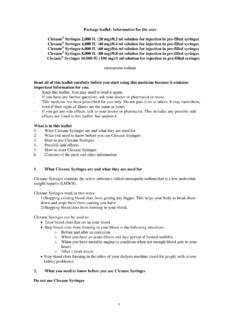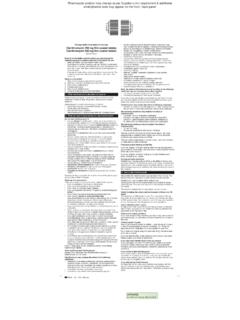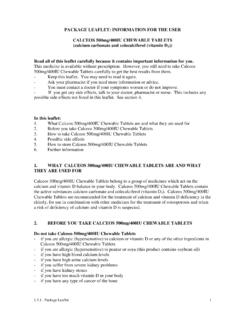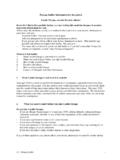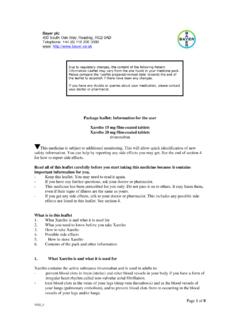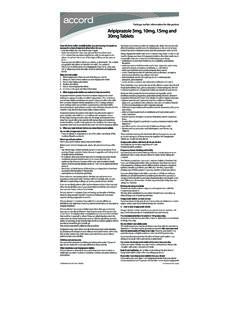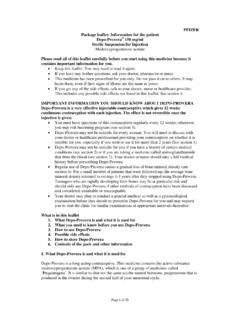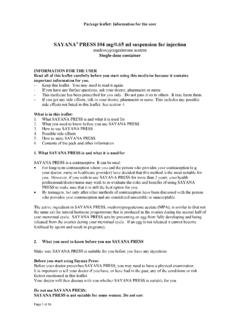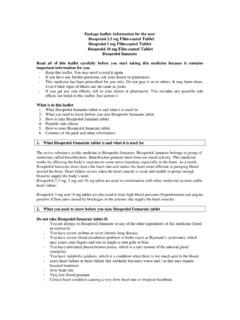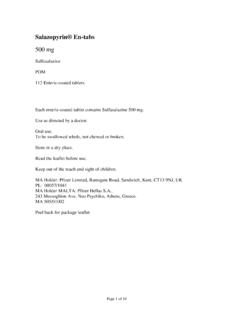Transcription of PACKAGE LEAFLET: INFORMATION FOR THE USER
1 1 PACKAGE leaflet : INFORMATION FOR THE user typhim Vi , Solution for injection Purified Vi Capsular Polysaccharide of Salmonella typhi (Ty 2 Strain). Read all of this leaflet carefully before you are vaccinated because it contains important INFORMATION for you. - Keep this leaflet . You may need to read it again. - If you have any further questions, ask your doctor, pharmacist or nurse. - This vaccine has been prescribed for you only. Do not pass it on to others. - If you get any side effects, talk to your doctor, pharmacist or nurse.
2 This includes any possible side effects not listed in this leaflet . See section 4. In this leaflet : 1. What typhim Vi is and what it is used for 2. Before typhim Vi is given 3. How typhim Vi is given 4. Possible side effects 5. How to store typhim Vi 6. Further INFORMATION 1. WHAT typhim Vi IS AND WHAT IT IS USED FOR typhim Vi is a vaccine. Vaccines are used to protect against infectious diseases. This vaccine helps to protect adults and children who are aged 2 years and over against typhoid fever. It may not be effective in children under 2.
3 When the vaccine is given to you or your child, the body s natural defences will produce protection against typhoid fever. Typhoid fever is an infectious disease. Symptoms are a headache with a fever that gets worse over three to four days. Additional symptoms include cough, sore throat and altered behaviour. This vaccine will only protect against typhoid fever. It will not work against any other disease, such as paratyphoid fever or food poisoning. It cannot cause typhoid fever. As with any vaccine, not everyone who receives this vaccine will definitely be protected against typhoid fever.
4 2. BEFORE typhim Vi IS GIVEN To make sure that this vaccine is suitable for you or your child, it is important to tell your doctor or nurse if any of the points below apply to you or your child. If there is anything you do not understand, ask your doctor or nurse to explain. Do not use this vaccine if you or your child is: allergic (hypersensitive) to typhim Vi or any of its ingredients (see section 6 for a list of ingredients). allergic (hypersensitive) to formaldehyde or casein, which are used during vaccine production and may be present in small amounts.
5 Ill with a high temperature. The vaccination will be delayed until you/your child have recovered. 2 Take special care with this vaccine Tell your doctor or nurse if you or your child has: a blood disorder such as haemophilia (a condition where you bruise or bleed easily) because bleeding may occur at the injection site. a poor or reduced immune system, due to: - corticosteroids, cytotoxic drugs, radiotherapy or any other treatment that weakens the immune system. The doctor or nurse may wait until the course of treatment has finished.
6 - HIV infection or any disease that weakens the immune system. The vaccine may not protect as well as it protects people with normal immune systems. Fainting can occur (mostly in adolescents) following, or even before, any needle injection. Therefore tell your doctor or nurse if you or your child fainted with a previous injection. Receiving other vaccines or medicines This vaccine can generally be given at the same time as other vaccines provided that they are given in different parts of the body ( the other arm or leg) and are not mixed in the same syringe.
7 This vaccine can be given at the same time as other common vaccines including: yellow fever diphtheria tetanus poliomyelitis rabies (prepared on Vero cells) meningitis A + C hepatitis A and hepatitis B Tell your doctor, nurse or pharmacist if you or your child are taking or have recently taken any other medicines, including medicines obtained without a prescription. Pregnancy and breast-feeding If you are pregnant, trying to become pregnant or are breast feeding, tell your doctor or nurse. They will decide whether or not to delay the vaccination.
8 Ask your doctor, nurse or pharmacist for advice before taking any medicine. Driving and using machines Tiredness has been reported in some people after receiving this vaccine so you must take extra care when driving or using machines. If you are affected do not drive or use machines. Important INFORMATION about some of the ingredients of typhim Vi Sodium: This vaccine contains less than 1 mmol sodium (23mg) per dose. This is a very small amount so is classed as sodium-free . 3. HOW typhim Vi IS GIVEN The vaccine will be given by a doctor or nurse who has been trained in the use of vaccines and who is equipped to deal with any uncommon severe allergic reaction to the injection.
9 Dosage typhim Vi is given as a single injection of half a millilitre of the vaccine to adults and children aged 2 years and over. The vaccine should be given at least 2 weeks before protection against typhoid fever is required. Protection lasts for 3 years so you or your child may need another dose after this time. 3 How the vaccine is administered The doctor or nurse will shake the syringe immediately before use and check that the liquid is not discoloured and has no unexpected particles in it. The vaccine is given as an injection into a muscle or deep under the skin, in the outer part of the upper arm or leg.
10 They will avoid giving the injection into a blood vessel. Your doctor or nurse will make a note of the details of the injection. If you have any further questions on the use of this vaccine, ask your doctor, nurse or pharmacist. 4. POSSIBLE SIDE EFFECTS Like all medicines, this vaccine can cause side effects, although not everybody gets them. Serious allergic reactions: Anaphylactic, anaphylactoid reactions, including shock which can include one or several of the following symptoms: o urticaria, skin rash, o swelling of face and/or neck, o breathing difficulties, bluish discoloration of the tongue or lips, o low blood pressure, rapid heart rate and weak pulse, skin coldness, dizziness and potentially fainting.
